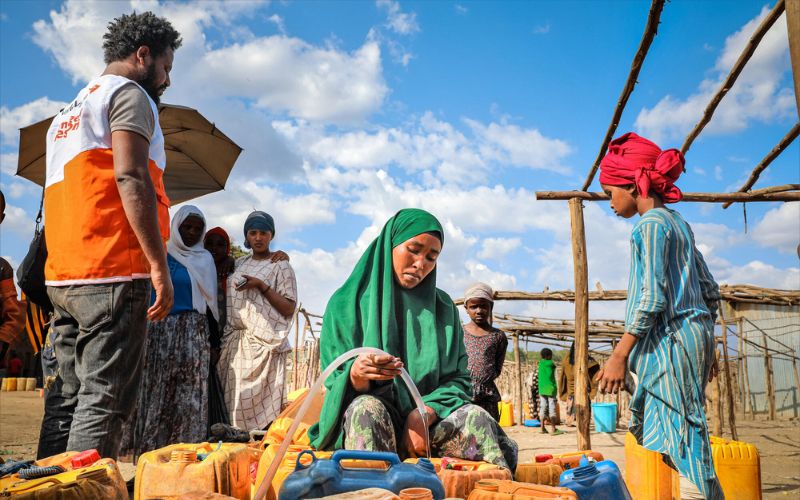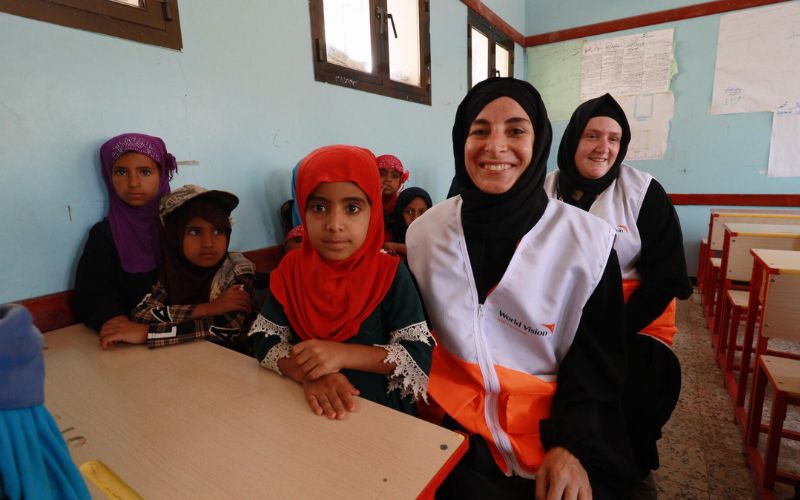By Sophia Papastravou, Gender Technical Specialist, World Vision Canada
Driven by a mix of climate shocks,
ongoing conflict and displacement, the
global hunger crisis is at an all-time high—marked by worsening food insecurity and diet quality.
When
pre-existing nutrition and hunger problems collide with conflict, communities become even more vulnerable to hunger, as access to food, water and sanitation worsens.
Marked by insufficient crop production and disrupted livelihoods, hunger continues to impact the lives of millions—especially women and girls. From harmful gender norms to devastating choices driven by survival, women and girls are undoubtedly the most impacted by
global hunger.
Hunger and gender norms
Women and girls are already more vulnerable to hunger and malnutrition due to discriminatory and harmful gender norms, such as practices where women and girls eat last and least. Women also face limited decision-making power, access to and control over productive resources, information and services and significant mobility restrictions. The labour burden of women and girls significantly exceeds that of men and boys, undermining their productive capacity and exacerbating challenges in meeting their nutrition needs.
Women and girls already eat last and least, so the combined impact of diminishing resources and limited decision-making power over allocation of increasingly scarce resources mean the Hunger Crisis will deepen the systemic inequality that holds women and girls back from realizing their right to good nutrition.
 Shemsi, a 26-year-old mother to two young children, fills up her water container from a World Vision water truck in her community in Ethiopia. Usually, she spends hours walking in search of clean water to feed and wash her children. Photo: Bethel Shiferaw Kebede
Shemsi, a 26-year-old mother to two young children, fills up her water container from a World Vision water truck in her community in Ethiopia. Usually, she spends hours walking in search of clean water to feed and wash her children. Photo: Bethel Shiferaw Kebede
Hunger and gender-based violence
Hunger and conflict are intertwined—and consequently, so is gender-based violence.
Widespread early forced marriages, violence against children and sexual and gender-based violence (SGBV) are fueled, in part, by reduced access to food and further exacerbated by war. Sexual violence in conflict zones is at the heart of the protection concerns for women living as refugees or who are displaced.
Women and girls are at high risk of SGBV and exploitation, including forced labour, child marriage and transactional sex, which not only violate multiple rights of women and girls but also have direct and indirect impact on their nutritional status and overall health.
Women continue to be targets of sexual violence as part of military agenda. Rape and other forms of sexual abuse are used as weapons of war allowing men to inflict harm on women as a means of degrading them, but more specifically their male partners, families and entire communities. This alternative form of aggression towards other men is written off as an unavoidable, inevitable consequence of war even though it violates women’s security and human rights.
World Vision’s response to hunger crises in multi-country projects in various countries such as Ethiopia, Somalia, South Sudan, Syria and Yemen has reached the most vulnerable women and children at risk of protection and SGBV violations through community-based protection mechanisms in these affected areas. Thus far, the projects have found that although the exact causes of hunger differ from country to country, there is evidence in almost all that violence against women is increasing.
How World Vision is responding
World Vision staff continue to work under critical and fragile conditions while providing lifesaving support to communities experiencing mass poverty and living in times of war. World Vision staff deliver urgent care to people living in crisis-affected areas and continue to risk their lives to ensure humanitarian assistance such as food, water and sanitation solutions, relief supplies, and shelter are delivered.
 This school in Yemen has become a safer place for girls to continue their studies, thanks to a new water tank and toilets. Having safe and sanitary washroom facilities in schools is life-saving and helps keep students, especially girls, in school. Photo: Karam Kamal
This school in Yemen has become a safer place for girls to continue their studies, thanks to a new water tank and toilets. Having safe and sanitary washroom facilities in schools is life-saving and helps keep students, especially girls, in school. Photo: Karam Kamal
Furthermore, emergency incentives and support with basic counselling are provided to SGBV survivors. SGBV survivors are also referred to police and safe uncles’ houses, other services providers. The existing protection committee members and community nutrition volunteers are trained on SGBV prevention, protection risks and available SGBV response services.
An essential component of addressing protection is the creation of women- and girl-friendly spaces which are established to facilitate basic psycho-social support activities to vulnerable lactating mothers accessing nutrition services. In this regard, health workers have received awareness training in SGBV and Child Protection violations including health and nutrition messaging.
To build resilience and address climate shocks, in Ethiopia, for example, women are provided with seedlings and farming equipment to plant their own home and neighborhood gardens. Women also form savings group with other women in the villages to fund micro-income generation activities.
 Women across the world are often forced to depend on their husbands to provide income for nutritious food. Mariam, 26, is part of a program in South Sudan that is pushing back on this gender norm by training women to their own vegetables for consumption and for supplementary household income. Photo: Scovia Faida Charles
Women across the world are often forced to depend on their husbands to provide income for nutritious food. Mariam, 26, is part of a program in South Sudan that is pushing back on this gender norm by training women to their own vegetables for consumption and for supplementary household income. Photo: Scovia Faida Charles
While the integration of SGBV awareness, mitigation, and response services in nutrition and health services are an integral part of the projects, the distribution of emergency kits for SGBV survivors, vulnerable women and adolescent girls (clothing, bedding, hygiene and dignity kits) is part of the projects’ upscaled and life-saving support.
While the hunger crisis rages on, the Global Hunger Crisis Response has come face to face with the tragic realities that
women and girls face and the devastating impact of food insecurity, conflict and the ongoing threat of sexual violence.
Learn more about World Vision’s work responding to the hunger crisis and stopping the resulting sexual and gender-based violence.